The post What is a Solar Street Light? appeared first on Blazer.
]]>Solar street lights are innovative, energy-efficient lighting solutions that utilize solar power to illuminate streets, highways, parking lots, and other public areas. These lights consist of solar panels, batteries, LED fixtures, and smart controllers, providing a sustainable and cost-effective alternative to traditional street lighting.
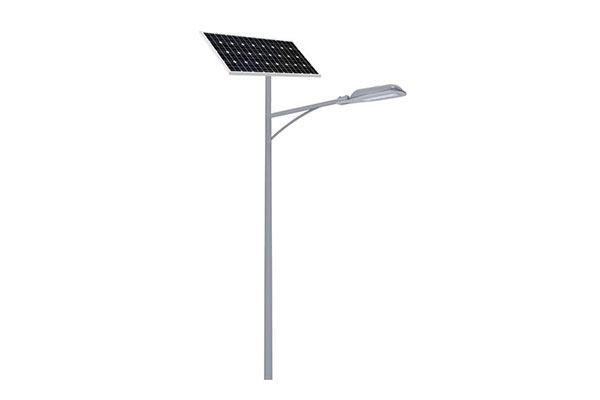
How Do Solar Street Lights Work?
Solar street lights operate by capturing sunlight through photovoltaic (PV) panels, converting it into electrical energy, and storing it in rechargeable batteries. At night, the stored energy powers LED lamps, ensuring consistent and reliable illumination. Modern solar street lights are equipped with intelligent sensors that automatically turn the lights on at dusk and off at dawn, further optimizing energy efficiency.
Key Components of a Solar Street Light
- Solar Panel – Converts sunlight into electricity.
- Battery – Stores energy to power the light at night.
- LED Light Fixture – Provides high-efficiency lighting with minimal energy consumption.
- Charge Controller – Regulates energy flow between the solar panel, battery, and LED light.
- Motion Sensors (Optional) – Adjust brightness based on movement to conserve energy.
Types of Solar Street Lights
1. All-in-One Solar Street Lights
These compact units integrate the solar panel, battery, and LED lamp into a single structure, making them easy to install and maintain.
2. Split Type Solar Street Lights
In these systems, the solar panel is separate from the LED fixture, allowing for better flexibility in installation and positioning.
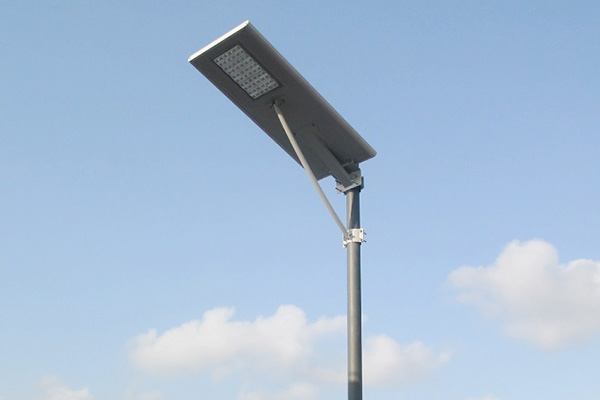
Benefits of Solar Street Lights
- Energy Efficiency: Utilizes renewable solar energy, reducing electricity costs.
- Eco-Friendly: Minimizes carbon footprint by eliminating dependence on fossil fuels.
- Low Maintenance: Requires minimal upkeep compared to traditional lighting systems.
- Easy Installation: No need for complex wiring or grid connection.
Applications of Solar Street Lights
Solar street lights are widely used in various applications, including:
- Urban and Rural Roads: Enhancing road safety and visibility.
- Parking Lots: Providing well-lit spaces for vehicles and pedestrians.
- Public Parks and Gardens: Ensuring security and aesthetic appeal.
- Industrial and Commercial Areas: Improving workplace safety and productivity.
- Remote and Off-Grid Locations: Delivering sustainable lighting solutions in areas without access to electricity.
Choosing the Right Solar Street Light
When selecting a solar street light, consider factors such as:
- Wattage and Brightness: Choose a suitable power output based on the area to be illuminated.
- Battery Capacity: Ensure sufficient battery storage to provide extended nighttime lighting.
- Weather Resistance: Opt for lights with IP65 or higher ratings to withstand harsh weather conditions.
- Smart Features: Consider models with motion sensors, timers, and remote monitoring for improved efficiency.
Conclusion
Solar street lights are a sustainable, cost-effective, and efficient alternative to traditional street lighting. They offer numerous benefits, including energy savings, easy installation, and low maintenance. Whether for roads, parking lots, or public spaces, solar street lights provide reliable illumination while contributing to a greener planet.
Looking for High-Quality Solar Street Lights?
If you’re interested in durable and efficient solar street lights, browse our wide range of solar lighting solutions today! Contact us for a customized quote.
The post What is a Solar Street Light? appeared first on Blazer.
]]>The post How Do Solar Panels Work? A Complete Guide appeared first on Blazer.
]]>With the growing shift toward renewable energy, solar panels have become a crucial solution for generating clean and sustainable power. But how do solar panels work? In this article, we’ll break down the science behind solar energy, how solar panels convert sunlight into electricity, and why they are an excellent investment for homes and businesses.
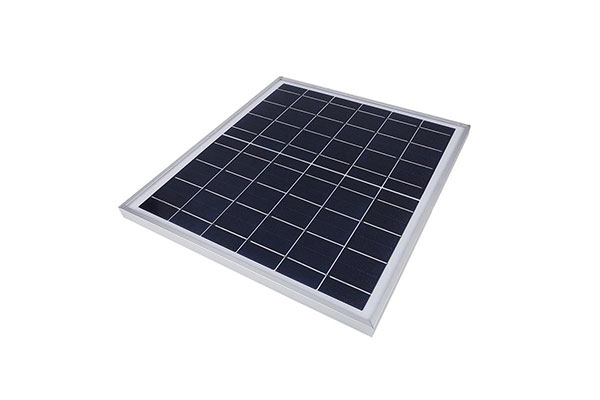
Understanding Solar Panels
Solar panels, also known as photovoltaic (PV) panels, are designed to capture sunlight and convert it into electricity. This process is based on the photovoltaic effect, which enables certain materials to generate an electric current when exposed to sunlight.
A complete solar power system typically consists of:
- Solar panels – Capture sunlight and generate electricity.
- Solar Inverter – Converts direct current (DC) electricity into alternating current (AC) electricity, which can be used by home appliances.
- Battery storage – Stores excess power for use when sunlight is not available.
- Charge controller – Regulates the voltage and current from solar panels to prevent overcharging of batteries.
- Electric meter – Tracks electricity usage and surplus energy sent back to the grid.
The Main Components of a Solar Panel
- Solar Cells – Made from semiconductor materials like silicon, these cells absorb sunlight and create an electric charge.
- Glass Cover – Protects the solar cells from environmental factors like dust and moisture.
- Encapsulation Layer – Holds the solar cells together while improving durability.
- Metal Frame – Provides structural support for easy installation.
- Wiring & Junction Box – Conducts and regulates the electricity generated by the panel.
Step-by-Step Process: How Solar Panels Work
The process of converting sunlight into usable electricity can be broken down into three key steps:
1. Absorbing Sunlight
Each solar panel consists of multiple photovoltaic cells, typically made of silicon. When sunlight hits these cells, it excites electrons, creating an electric current.
2. Generating Direct Current (DC) Electricity
The movement of electrons generates direct current (DC) electricity. However, most homes and businesses use alternating current (AC) electricity, which requires conversion.
3. Converting DC to AC Electricity
A solar inverter is used to convert DC electricity into AC electricity, making it compatible with household appliances and the electrical grid.
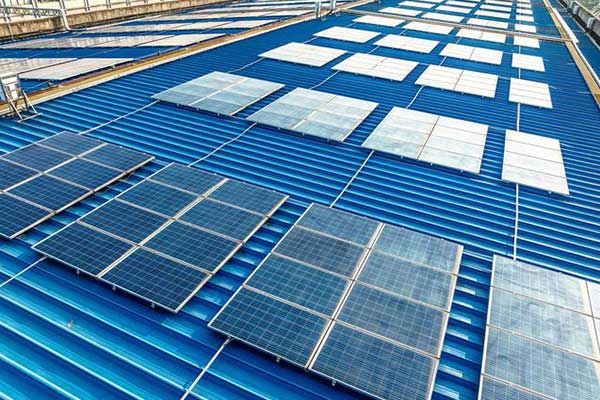
Types of Solar Panels
There are three main types of solar panels:
- Monocrystalline Solar Panels – High efficiency, long lifespan, and best performance in low-light conditions.
- Polycrystalline Solar Panels – More affordable but slightly less efficient than monocrystalline panels.
- Thin-Film Solar Panels – Lightweight and flexible, ideal for specific applications like portable solar chargers.
Benefits of Using Solar Panels
- Renewable Energy Source: Sunlight is free and abundant.
- Reduces Electricity Bills: Generating your own power can significantly lower energy costs.
- Eco-Friendly: Solar panels reduce carbon emissions and environmental impact.
- Low Maintenance: Once installed, solar panels require minimal maintenance.
- Energy Independence: Reduces reliance on traditional energy sources and grid power.
Conclusion
Solar panels work by converting sunlight into electricity through the photovoltaic effect. This clean, renewable energy source is an excellent way to reduce energy costs and minimize environmental impact. Whether for residential or commercial use, solar panels provide long-term benefits and contribute to a more sustainable future.
The post How Do Solar Panels Work? A Complete Guide appeared first on Blazer.
]]>The post All in One vs. Split Solar Street Light: How to Choose appeared first on Blazer.
]]>Solar street lights are gaining popularity worldwide due to their energy efficiency, sustainability, and cost-effectiveness. However, when choosing between all in one and split solar street lights, many buyers are unsure which type best suits their needs. In this article, we’ll compare the two, highlighting their advantages, disadvantages, and best applications to help you make an informed decision.
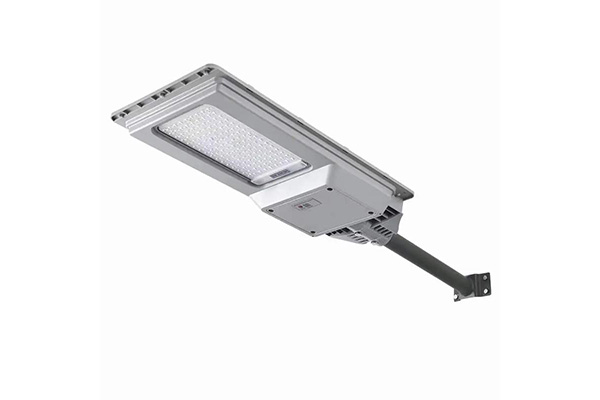
What is an All in One Solar Street Light?
An all in one solar street light integrates the solar panel, battery, LED light, and controller into a single compact unit. It is designed for easy installation and low maintenance, making it an attractive choice for many users.
Advantages of All in One Solar Street Lights
- Easy Installation – Since all components are in one unit, installation is quick and doesn’t require complex wiring.
- Low Maintenance – The integrated design minimizes the risk of wiring issues and reduces maintenance costs.
- Sleek & Modern Design – All-in-one lights have a compact and aesthetically pleasing appearance.
- Energy Efficient – Advanced technology, including MPPT controllers and motion sensors, helps optimize energy usage.
- Cost-Effective – Lower installation and maintenance costs make these lights more affordable in the long run.
Disadvantages of All in One Solar Street Lights
- Limited Solar Panel Size – Since the panel is attached to the light, its size is restricted, reducing energy absorption in low-sunlight areas.
- Battery Capacity Constraints – The compact design means the battery is smaller, which may limit operation time in cloudy weather.
- Difficult Component Replacement – If one part fails, the entire unit may need replacement.
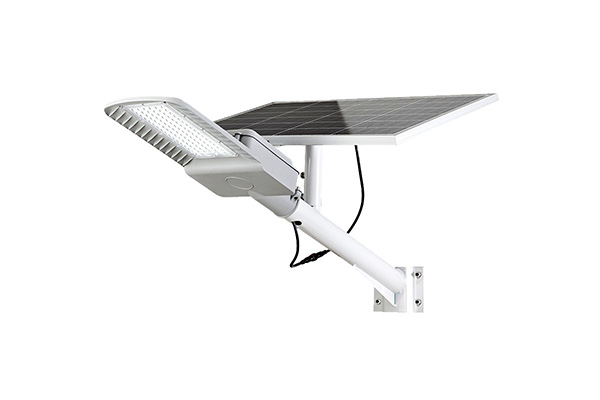
What is a Split Solar Street Light?
A split solar street light has separate components: the solar panel, LED light, battery, and controller are installed separately. This allows for more flexibility in system design and customization.
Advantages of Split Solar Street Lights
- Larger Solar Panel – Since the panel is separate, it can be larger, capturing more sunlight and generating more energy.
- Higher Battery Capacity – The battery can be placed separately, allowing for a larger capacity and longer backup time.
- More Flexibility in Installation – The solar panel can be positioned for maximum sunlight exposure, even in shaded areas.
- Easier Component Replacement – If one part fails, it can be replaced without changing the entire system.
Disadvantages of Split Solar Street Lights
- More Complex Installation – Requires additional wiring and mounting, increasing labor and setup costs.
- Higher Initial Cost – More components and installation complexity make this type of light more expensive initially.
- Increased Maintenance – Since parts are separate, wiring and connections need regular inspection and maintenance.
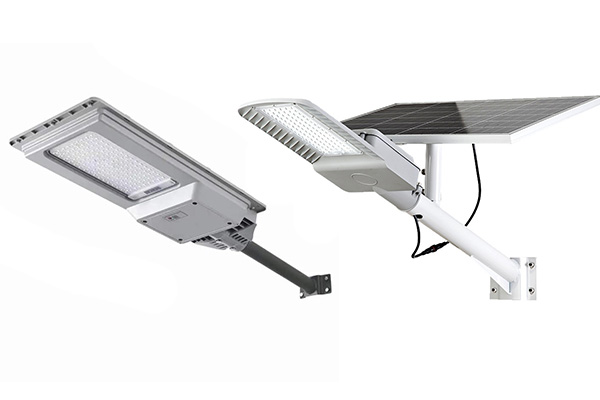
Comparison Table: All in One vs. Split Solar Street Light
| Feature | All in One Solar Street Light | Split Solar Street Light |
|---|---|---|
| Installation | Easy, plug-and-play | More complex, requires wiring |
| Maintenance | Low | Higher, requires inspections |
| Solar Panel Size | Limited due to integration | Larger for more energy absorption |
| Battery Capacity | Smaller | Larger, provides longer backup |
| Aesthetics | Compact and modern | Bulkier due to separate components |
| Cost | Lower initial and installation cost | Higher initial cost but customizable |
Which One Should You Choose?
The choice between all in one and split Solar Street Lights depends on various factors, including budget, location, and lighting requirements.
Choose All in One Solar Street Lights if:
- You need a quick and easy installation with minimal maintenance.
- Your project is in an urban or residential setting with moderate lighting needs.
- A compact and aesthetically pleasing design is a priority.
Choose Split Solar Street Lights if:
- You require high-wattage lighting for highways, large streets, or industrial areas.
- You want greater flexibility in solar panel positioning for better energy efficiency.
- Your project requires long-term durability and extended battery life.
Conclusion
Both all in one and split solar street lights have their advantages and are suited for different applications. Before making a decision, consider your location, budget, and specific lighting needs to ensure the best performance and cost-effectiveness for your project.
Need high-quality solar street lights? Contact us today to find the best solution for your needs!
The post All in One vs. Split Solar Street Light: How to Choose appeared first on Blazer.
]]>The post How Long Do Solar Street Lights Last? appeared first on Blazer.
]]>Solar street lights are an eco-friendly and cost-effective lighting solution for streets, highways, parking lots, and public spaces. As more cities and businesses invest in solar-powered lighting, one common question arises: How long do solar street lights last? Understanding the lifespan of solar street lights can help in making informed purchasing decisions and ensuring long-term performance.
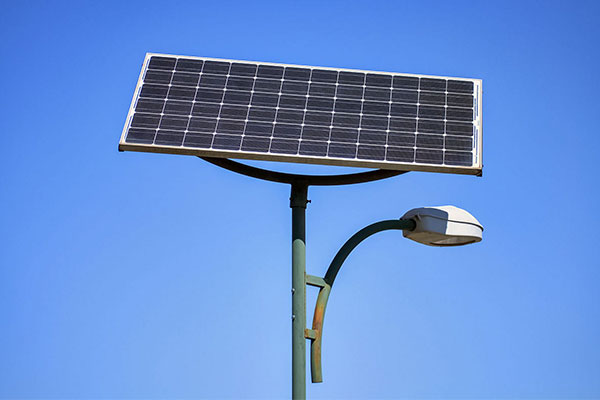
Average Lifespan of Solar Street Lights
The lifespan of solar street lights depends on various factors, including the quality of components, environmental conditions, and maintenance. Here’s a breakdown of the key components and their average lifespans:
1. Solar Panels
Solar panels are a crucial part of solar street lights, as they capture sunlight and convert it into electricity. High-quality monocrystalline or polycrystalline solar panels typically last 20to 25 years with proper maintenance.
2. LED Light Fixtures
LED lights are commonly used in solar street lights due to their high energy efficiency and longevity. A good-quality LED light can last 50,000 to 100,000 hours, which translates to 10 to 20 years, depending on usage.
3. Battery Life
The battery is responsible for storing the solar energy and powering the lights at night. The type of battery used significantly affects the overall lifespan of the solar street light:
- Lithium-ion or LiFePO4 batteries – Typically last 5 to 10 years.
- Lead-acid batteries – Have a shorter lifespan of around 3 to 5 years.
4. Charge Controller and Other Electronics
The charge controller regulates the power flow between the solar panel, battery, and LED light. A high-quality charge controller can last 5 to 10 years before requiring replacement.
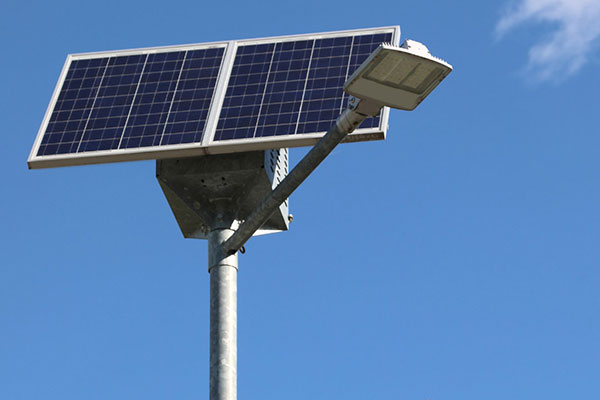
Factors Affecting Solar Street Light Lifespan
Several external factors can influence the longevity of a solar street light system, including:
- Weather Conditions – Extreme heat, cold, rain, and snow can impact battery performance and LED longevity.
- Maintenance – Regular inspections and cleaning improve efficiency and extend the system’s lifespan.
- Quality of Components – Investing in high-quality materials ensures better durability and long-term performance.
- Installation Location – Proper positioning for maximum sunlight exposure enhances solar panel efficiency.
How to Extend the Lifespan of Solar Street Lights
- Use Lithium Batteries: Opt for LiFePO4 batteries for better longevity.
- Ensure Proper Positioning: Install solar panels in areas with maximum sunlight exposure.
- Perform Routine Maintenance: Regularly inspect and clean components.
- Choose High-Quality Products: Invest in trusted brands for long-lasting performance.
Conclusion
Solar street lights are a long-term investment that can last 10–25 years, depending on the quality of their components and maintenance. While solar panels and LED lights can last over 20 years, the battery may need replacement every 5–8 years. Choosing high-quality materials, ensuring proper installation, and performing regular maintenance will maximize the lifespan of solar street lights.
Looking for reliable and durable solar street lights? Contact us today to find the best solar lighting solutions for your needs!
The post How Long Do Solar Street Lights Last? appeared first on Blazer.
]]>The post What is All in One Solar Street Light? appeared first on Blazer.
]]>As the demand for sustainable and cost-effective lighting solutions grows, all in one solar street lights have emerged as a popular choice for urban and rural areas. These innovative lighting systems integrate all essential components into a single unit, making them easy to install and maintain. But what exactly is an all in one solar street light, and why is it becoming a preferred option for outdoor lighting?
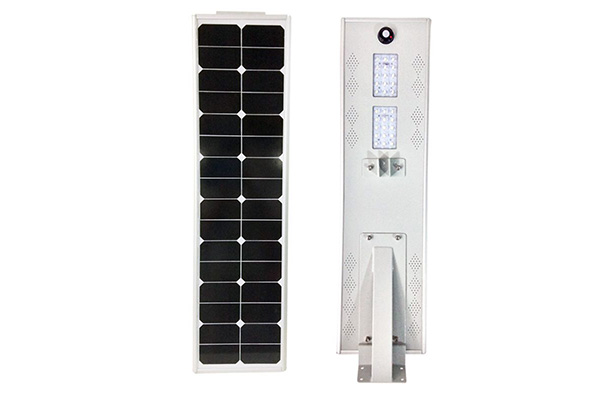
Understanding All in One Solar Street Lights
An all in one solar street light is a self-sufficient, compact lighting system that combines a solar panel, LED light, lithium battery, charge controller, and motion sensor in one integrated design. Unlike traditional solar street lights, which have separate components connected through wiring, all-in-one models are designed for quick installation and minimal maintenance.
Key Components of All in One Solar Street Lights
- Solar Panel – Captures sunlight and converts it into electricity to charge the battery.
- Lithium Battery – Stores energy for nighttime use and ensures long-lasting performance.
- LED Light – Provides bright illumination with energy-efficient technology.
- Charge Controller – Manages power flow between the solar panel and battery to prevent overcharging or deep discharge.
- Motion Sensor – Detects movement and adjusts brightness accordingly to save energy.
- Housing Unit – A durable, weather-resistant casing that protects internal components.
Advantages of All in One Solar Street Lights
1. Easy Installation
Since all components are integrated into one unit, all in one solar street lights eliminate the need for complicated wiring and trenching, reducing installation costs and time.
2. Energy Efficiency and Cost Savings
These lights use solar energy, which is free and renewable. The motion sensor technology allows the lights to operate at full brightness only when needed, saving energy and extending battery life.
3. Low Maintenance
With no external wiring and a long-lasting lithium battery, maintenance requirements are minimal, making them ideal for remote areas.
4. Weatherproof and Durable
Manufactured with IP65 or higher-rated waterproof materials, all in one solar street lights withstand harsh weather conditions, including rain, snow, and extreme temperatures.
5. Environmentally Friendly
By reducing reliance on fossil fuels and decreasing carbon emissions, all in one solar street lights contribute to a greener and more sustainable future.
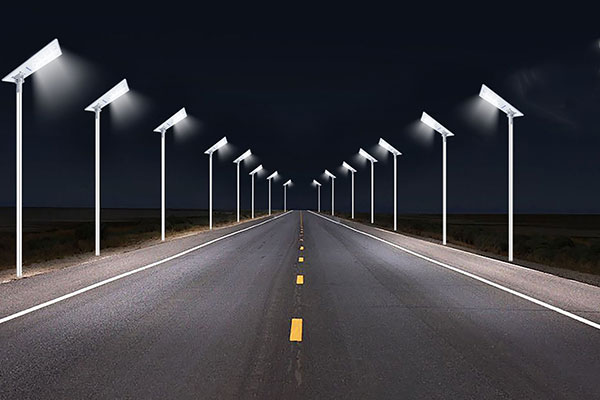
Applications of All in One Solar Street Lights
Due to their versatility, all in one solar street lights are used in various outdoor settings, including:
- Urban and Rural Roads – Enhancing road safety and visibility.
- Parking Lots – Providing reliable lighting without requiring grid power.
- Parks and Public Spaces – Ensuring security and accessibility at night.
- Residential Areas – Offering an efficient alternative to conventional streetlights.
- Industrial and Commercial Premises – Improving security and operational efficiency.
How to Choose the Best All in One Solar Street Light?
When selecting an all-in-one solar street light, consider the following factors:
- Wattage and Lumens Output – Ensure it provides sufficient brightness for your needs.
- Battery Capacity – Choose a model with a high-capacity lithium battery for extended operation.
- Solar Panel Efficiency – Higher efficiency panels convert more sunlight into usable energy.
- Motion Sensor Sensitivity – Opt for adjustable settings to optimize energy savings.
- Weather Resistance – Ensure it has an IP65 or higher rating for durability.
Conclusion
All in one solar street lights are an innovative and eco-friendly solution for outdoor lighting. Their integrated design, ease of installation, and low maintenance make them a cost-effective choice for various applications. As technology advances, these lights will continue to play a significant role in sustainable urban development and smart city solutions.
If you’re looking for high-quality all in one solar street lights, you can contact us directly for more information.
The post What is All in One Solar Street Light? appeared first on Blazer.
]]>The post How Long Do Solar Water Pumps Last? appeared first on Blazer.
]]>In the realm of sustainable living and renewable energy, solar water pumps stand as indispensable tools. Offering a reliable and eco-friendly solution for water pumping needs, they have gained substantial traction in agricultural, residential, and industrial sectors alike. However, an essential question often arises among potential users and enthusiasts: How long do solar water pumps last?
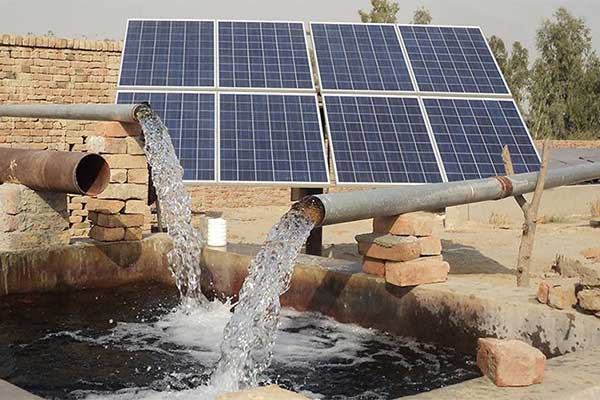
Expected Lifespan
The lifespan of a solar water pump can vary depending on several factors, but on average, these systems are designed to last between 15 to 25 years. With proper maintenance and care, some pumps may exceed this timeframe, providing reliable water pumping solutions for decades. However, it’s essential to monitor performance regularly and address any issues promptly to ensure the longevity of the system.
Factors Affecting Longevity
1. Quality of Components:
The durability and reliability of a solar water pump primarily hinge on the quality of its components. Opting for reputable brands and high-grade materials ensures longevity and reduces the risk of premature failures.
2. Maintenance Practices:
Regular maintenance is the cornerstone of extending the lifespan of any mechanical system, including solar water pumps. Routine checks for debris, dust accumulation, and component wear can preemptively address potential issues and prolong the pump’s operational life.
3. Environmental Conditions:
Solar water pumps operate in diverse environments, from arid deserts to humid tropics. Factors such as temperature fluctuations, humidity levels, and exposure to harsh elements can impact the system’s performance and longevity. Proper installation and protection measures tailored to specific environmental conditions are essential.
4. Usage Intensity:
The frequency and duration of usage significantly influence the wear and tear experienced by solar water pumps. Overworking the system beyond its design specifications can accelerate component degradation and shorten its lifespan. Matching the pump’s capacity to the intended application is crucial for ensuring longevity.
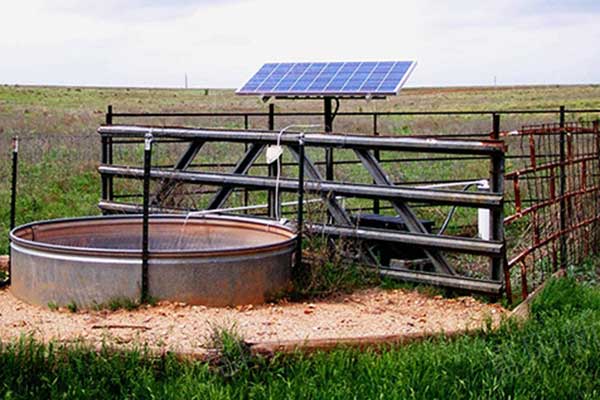
Maximizing Efficiency and Lifespan
1. Professional Installation:
A well-executed installation by experienced professionals ensures optimal performance and longevity of solar water pumps. Proper alignment, secure mounting, and adequate ventilation are critical for preventing premature failures.
2. Regular Inspections:
Implementing a schedule for routine inspections allows early detection of potential issues and timely maintenance interventions. Checking for leaks, loose connections, and signs of wear can mitigate risks and extend the pump’s lifespan.
3. Adaptive Maintenance:
Tailoring maintenance practices to changing environmental conditions and usage patterns optimizes the efficiency and longevity of solar water pumps. Periodically reassessing maintenance schedules and adjusting them accordingly can address emerging issues proactively.
Conclusion
Solar water pumps offer a sustainable and reliable solution for various water pumping needs, with their longevity influenced by multiple factors such as component quality, maintenance practices, environmental conditions, and technological advancements. While the exact lifespan can vary, a well-maintained solar water pump typically lasts between 15 to 25 years. By adhering to best practices in installation, maintenance, and usage, users can maximize the efficiency and lifespan of these indispensable systems, ensuring uninterrupted water supply while minimizing environmental impact. Investing in quality components and staying abreast of technological innovations further enhances the reliability and longevity of solar water pumps.
The post How Long Do Solar Water Pumps Last? appeared first on Blazer.
]]>The post How Much is a Solar Water Pump? A Comprehensive Guide appeared first on Blazer.
]]>In recent years, the demand for sustainable and eco-friendly solutions has led to increased interest in solar-powered technologies. One such innovation making waves in the agricultural and water supply sectors is the solar water pump. Harnessing the power of the sun to pump water efficiently, these systems offer a clean and cost-effective alternative to traditional water pumping methods. If you’re considering investing in a solar water pump, it’s crucial to understand the various factors influencing its cost.
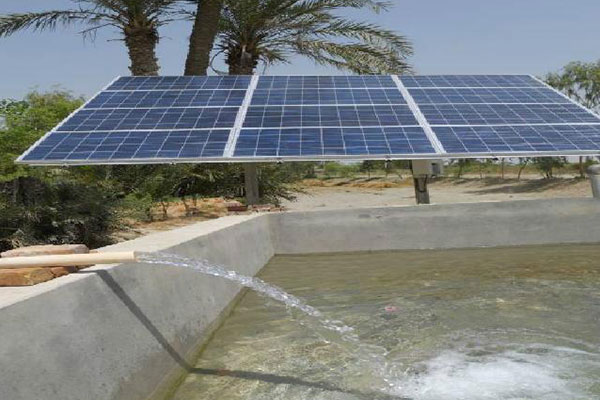
Factors Affecting the Cost of Solar Water Pumps:
1. Pump Capacity and Depth:
The capacity and depth to which the pump needs to lift water play a significant role in determining its cost. Higher capacities and deeper water sources may require more advanced and powerful solar water pump systems, affecting the overall price.
2. Solar Panel Capacity:
The heart of any solar-powered system lies in its solar panels. The capacity of the solar panels needed depends on the pump’s power requirements and the sunlight available in your location. Larger solar panel systems typically come with a higher price tag.
3. Pump Type:
Different types of solar water pumps cater to specific needs. Submersible pumps, surface pumps, and centrifugal pumps each have their advantages and price variations. Understanding your water requirements and the pump type suitable for your situation is crucial in estimating costs.
4. Installation and Maintenance:
Professional installation ensures optimal performance and longevity of your solar water pump. Installation costs may vary based on factors like location, terrain, and the complexity of the installation process. Additionally, ongoing maintenance costs should be considered for long-term sustainability.
5. Quality and Brand:
The market is flooded with various solar water pump brands, each offering different features and qualities. Investing in a reputable brand might come with a higher initial cost, but it often ensures durability, efficiency, and better long-term performance.
6. Government Incentives and Subsidies:
Many governments around the world offer incentives and subsidies to promote the use of renewable energy systems, including solar water pumps. Researching and taking advantage of these programs can significantly reduce your overall investment.
Approximate Price Range:
- Small to Medium-sized Systems (1-5 HP): $1,500 – $5,000.
- Medium to Large-sized Systems (5-10 HP): $5,000 – $15,000 or more.
- High-capacity Systems (10+ HP): $15,000 and above.
Conclusion:
While the initial cost of a solar water pump may seem higher than traditional alternatives, it’s essential to consider the long-term benefits and environmental impact. Solar water pumps not only reduce electricity bills but also contribute to a sustainable and eco-friendly future. Understanding the factors influencing the cost will help you make an informed decision based on your specific needs and budget. As solar technology continues to advance, the affordability and efficiency of solar water pumps are expected to improve, making them an increasingly viable option for water pumping needs across various applications.
The post How Much is a Solar Water Pump? A Comprehensive Guide appeared first on Blazer.
]]>The post What is a Solar Water Pump? appeared first on Blazer.
]]>In an era marked by increasing environmental awareness and the need for sustainable solutions, solar technology has emerged as a powerful force. Solar water pumps are a prime example of how we can utilize the sun’s energy to address pressing issues like water scarcity and dependence on fossil fuels.
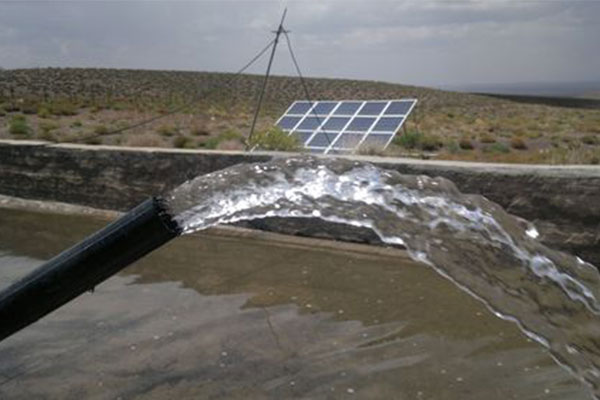
What is a Solar Water Pump?
A solar water pump is a device designed to utilize solar energy to pump water from a water source, such as a well, borehole, or reservoir, to a destination, like a storage tank or irrigation system. Unlike traditional water pumps that rely on electricity or fuel, solar water pumps operate solely on the power generated by photovoltaic (PV) panels. These panels capture sunlight and convert it into electrical energy, which, in turn, powers the water pump.
Applications of Solar Water Pumps
Solar water pumps find application in a variety of sectors, making them versatile and valuable for both residential and commercial use:
- Agriculture: Solar water pumps are widely used in agriculture for irrigation purposes. They enable farmers to water their crops efficiently, reducing their dependence on non-renewable energy sources and cutting operational costs.
- Remote Areas: In regions without access to a stable grid connection, solar water pumps offer a lifeline by providing a consistent water supply for domestic use, livestock, and agriculture.
- Recreational Areas: Solar water pumps can be used in parks, golf courses, and recreational facilities for water features, landscaping, and maintaining ponds.
Benefits of Solar Water Pumps
- Environmentally Friendly: Solar water pumps operate without emitting greenhouse gases, reducing carbon footprints and contributing to a sustainable, eco-friendly environment.
- Cost-Efficient: By eliminating the need for electricity or fuel, solar water pumps reduce operational costs, making them a cost-effective long-term investment.
- Reliable and Durable: Solar water pumps are built to withstand harsh weather conditions and provide reliable performance in remote areas.
- Energy Independence: Solar water pumps provide energy independence, ensuring a consistent water supply, even in off-grid locations.
- Government Incentives: In many regions, governments provide incentives and subsidies to encourage the adoption of solar water pumps, making them an even more attractive choice.
Conclusion
Solar water pump is a shining example of how sustainable technology can address critical water supply issues while promoting environmental conservation. By harnessing the power of the sun, these pumps offer reliable, cost-efficient, and eco-friendly solutions for a variety of applications, from agricultural irrigation to domestic water supply.
The post What is a Solar Water Pump? appeared first on Blazer.
]]>The post Solar Water Pumps: Advantages and Disadvantages appeared first on Blazer.
]]>Solar water pumps are a revolutionary solution for harnessing the power of the sun to provide a reliable source of water for various applications, including irrigation, livestock, and domestic use. These pumps offer a sustainable and eco-friendly alternative to traditional electric or diesel-powered pumps. In this article, we’ll explore the advantages and disadvantages of solar water pumps to help you make an informed decision for your specific needs.
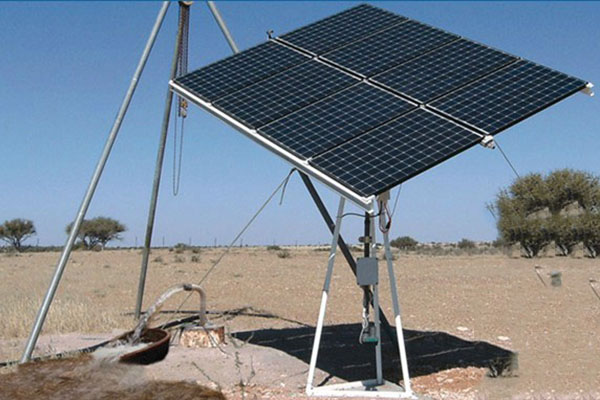
Advantages of Solar Water Pumps
1. Environmentally Friendly
One of the primary advantages of solar water pumps is their eco-friendliness. They produce no greenhouse gas emissions or air pollutants, making them a clean and sustainable choice. By harnessing solar energy, these pumps reduce your carbon footprint and help combat climate change.
2. Energy Cost Savings
Solar water pumps are powered by the sun, which means no ongoing fuel or electricity costs. Once installed, they provide free energy for many years, significantly reducing operational expenses. This can be especially advantageous for farmers and remote communities looking to save on energy costs.
3. Low Maintenance
Compared to traditional pumps that rely on complex machinery, solar water pumps have fewer moving parts, leading to lower maintenance requirements. Routine check-ups and occasional cleaning are generally sufficient to keep them in good working condition, reducing downtime and repair costs.
4. Remote Accessibility
Solar water pumps are an excellent solution for areas without access to grid electricity. They can be installed in remote locations, helping communities and farms in off-grid regions gain access to a consistent water supply for irrigation or other essential needs.
5. Long Lifespan
Solar water pumps are built to last. With minimal wear and tear on the components, these pumps can have a lifespan of 20-25 years or more, ensuring long-term water supply reliability.
6. Customizable
Solar water pump systems can be customized to suit specific requirements. They are available in various sizes and configurations, making it easy to adapt them to the unique needs of your application.
Disadvantages of Solar Water Pumps
1. High Initial Cost
The upfront cost of purchasing and installing a solar water pump system can be a significant barrier for some users. While there are long-term savings on energy and maintenance costs, the initial investment can be substantial.
2. Weather Dependence
The efficiency of solar water pumps is weather-dependent. Cloudy or rainy days can reduce the amount of energy generated, impacting the pump’s performance. This makes them less reliable during extended periods of inclement weather unless additional energy storage solutions like batteries are integrated.
3. Seasonal Variation
Solar water pumps may have reduced output during certain seasons, especially in regions with long winters or monsoon periods. This seasonal variation can affect their reliability for year-round applications.
4. Installation and Technical Expertise
Proper installation and maintenance require a certain level of technical expertise. It’s essential to hire professionals with experience in solar water pump systems to ensure optimal performance.
5. Limited Water Output
Compared to larger traditional pumps, solar water pumps may have limitations on the volume of water they can deliver. This may not be suitable for applications that require extremely high water flow rates.
Conclusion
Solar water pumps offer numerous advantages, including their environmental friendliness, cost savings, and low maintenance requirements. However, they do come with certain disadvantages, such as the high initial cost and weather-dependent performance. The decision to use a solar water pump should be based on your specific needs, location, and budget. When chosen and installed correctly, they can provide a reliable and sustainable source of water for years to come, making them a viable option for many agricultural, domestic, and remote water supply needs.
The post Solar Water Pumps: Advantages and Disadvantages appeared first on Blazer.
]]>The post Are Solar Water Pumps Any Good appeared first on Blazer.
]]>As concerns about climate change and the environment continue to grow, so does the interest in sustainable and eco-friendly alternatives for various aspects of our lives. One such alternative gaining popularity in the agricultural sector is solar water pumps. These devices offer a compelling solution to address the challenges of water scarcity, rising energy costs, and environmental sustainability in agriculture. But are solar water pumps any good? In this article, we will explore the many advantages of solar water pumps and why they are an excellent choice for modern farming.
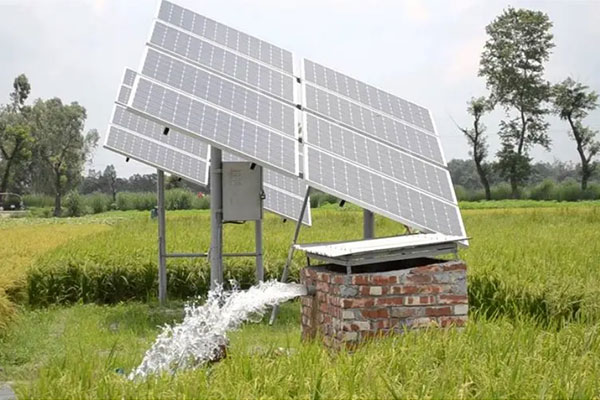
1. Eco-Friendly Operation
One of the most significant advantages of solar water pumps is their eco-friendly operation. Unlike traditional diesel or electric pumps that produce harmful emissions and contribute to air pollution, solar water pumps rely on renewable energy from the sun. They generate no greenhouse gas emissions and have a minimal environmental impact, making them a responsible choice for environmentally-conscious farmers.
2. Cost Savings
Solar water pumps can lead to substantial cost savings over time. While the initial investment may be higher than traditional pumps, the ongoing operating costs are significantly lower. Solar energy is free and abundant, and once the system is in place, maintenance costs are relatively minimal. In many cases, farmers can recoup their investment within a few years through reduced electricity bills and fuel costs.
3. Reliable and Low Maintenance
Solar water pumps are known for their reliability and low maintenance requirements. They have fewer moving parts than traditional pumps, which means less wear and tear. This results in a longer lifespan and reduced maintenance expenses. In addition, many solar pump systems come with remote monitoring and control capabilities, allowing farmers to detect and address issues quickly, further minimizing downtime.
4. Off-Grid Capabilities
For farmers in remote or off-grid locations, solar water pumps are a game-changer. They provide a dependable source of water without the need for a grid connection, which can be expensive and unreliable in some areas. This independence from the grid ensures that farmers can access water when they need it, even in remote or underserved regions.
5. Customizable Solutions
Solar water pumps come in a variety of sizes and configurations to suit different agricultural needs. Whether you need a small system for a garden or a large-scale setup for irrigation, there is a solar pump solution that can meet your requirements. This customization ensures that you get the right amount of water exactly where you need it.
6. Water Efficiency
Water scarcity is a significant concern in agriculture. Solar water pumps can be equipped with advanced irrigation systems that deliver water directly to the root zones of plants, reducing water wastage. This not only conserves water but also contributes to better crop yields and healthier plants.
Conclusion
Are solar water pumps any good? The answer is a resounding yes. These eco-friendly, cost-effective, and reliable devices are transforming modern farming by offering a sustainable solution to water management. They reduce environmental impact, save money, require minimal maintenance, and can operate off-grid. With customizable options to suit various agricultural needs and water-efficient capabilities, solar water pumps are a wise choice for farmers looking to embrace sustainable and responsible farming practices. By harnessing the power of the sun, solar water pumps are helping to secure the future of agriculture while preserving our environment.
Get Quality Solar Water Pumps
Blazer Engineering Machinery is a professional solar water pump manufacturer and supplier. It has many product models to meet the different needs of customers. It has a professional team and high-quality after-sales service. If you are looking for a solar water pump, you can contact us directly for more information.
The post Are Solar Water Pumps Any Good appeared first on Blazer.
]]>The post What is Integrated Solar Street Light? appeared first on Blazer.
]]>In today’s world, as sustainability and environmental consciousness take center stage, integrated solar street lights have emerged as a shining example of how technology can address the pressing need for energy-efficient and eco-friendly lighting solutions. These innovative devices are transforming urban landscapes and offering a cleaner, more sustainable way to illuminate our streets and public spaces.
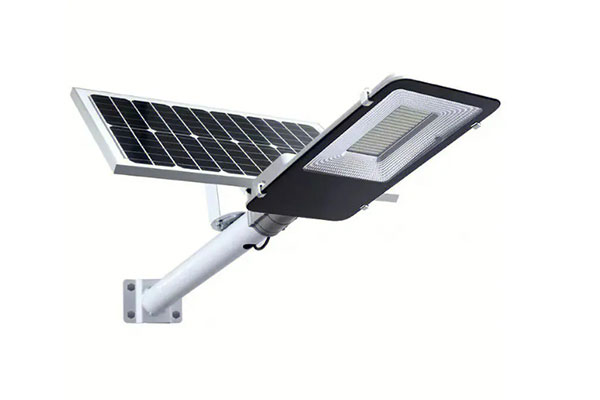
What is Integrated Solar Street Lights?
Integrated solar street lights, also known as all-in-one solar street lights, are a modern, energy-efficient alternative to traditional grid-connected street lights. These systems combine solar panels, high-efficiency LED lights, energy storage, and intelligent control technology into a single unit. The result is a self-sustaining lighting solution that harnesses the power of the sun to provide illumination during the night.
How Integrated Solar Street Lights Work
- Solar Panels: Integrated solar street lights are equipped with high-quality solar panels that convert sunlight into electrical energy. These panels are typically installed on the top of the streetlight’s pole, ensuring maximum exposure to sunlight.
- Energy Storage: The captured solar energy is stored in a rechargeable lithium-ion or lead-acid battery. This battery acts as an energy reservoir, allowing the street light to operate even when there is no sunlight, such as during nighttime or cloudy days.
- LED Lights: The energy-efficient LED lights are integrated into the streetlight unit. These lights produce a bright and focused illumination, and they consume significantly less energy compared to traditional streetlighting options.
- Intelligent Control: Integrated solar street lights are equipped with intelligent control systems. These systems include light sensors, motion sensors, and timers. They can automatically adjust the brightness of the LED lights based on the surrounding lighting conditions and detect movement, brightening the lights when someone approaches.
Benefits of Integrated Solar Street Lights
- Energy Efficiency: Integrated solar street lights are highly energy-efficient, as they rely on clean solar energy to power their LED lights. This results in lower energy bills and reduced environmental impact.
- Environmental Sustainability: By using renewable energy from the sun, integrated solar street lights reduce greenhouse gas emissions and reliance on fossil fuels, making them a sustainable choice for a greener future.
- Cost Savings: While the initial investment in integrated solar street lights may be higher than traditional street lighting, the long-term savings in energy and maintenance costs make them a cost-effective solution.
- Low Maintenance: These lights require minimal maintenance since they have no complex wiring or fuel requirements. This reduces ongoing operational costs.
- Reliability: The inclusion of energy storage ensures that integrated solar street lights can provide illumination even on overcast days or during power outages.
- Flexibility: Integrated solar street lights can be installed in remote or off-grid areas where grid power is not readily available, making them suitable for a wide range of applications.
Conclusion
Integrated solar street lights have emerged as a smart and sustainable solution for urban and rural lighting needs. These all-in-one systems efficiently harness the power of the sun to provide clean, reliable, and cost-effective illumination. With their energy efficiency, environmental benefits, and low maintenance requirements, integrated solar street lights are lighting the way toward a brighter and more sustainable future for our cities and communities.
The post What is Integrated Solar Street Light? appeared first on Blazer.
]]>The post How Do Solar Panels Work: A Comprehensive Guide appeared first on Blazer.
]]>Solar panels have become increasingly popular in recent years as a clean and sustainable source of energy. They harness the power of the sun to generate electricity and are used in a wide range of applications, from powering homes to running calculators. But how do solar panels work?
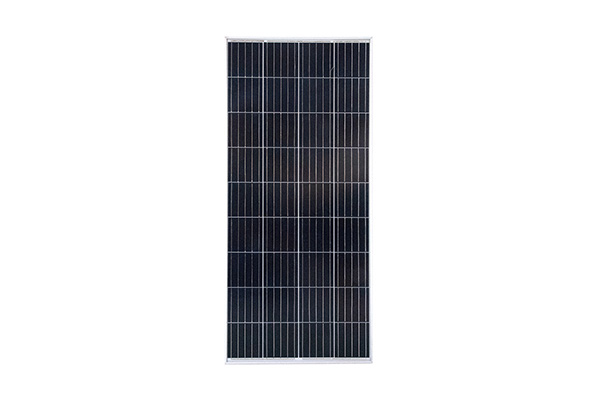
What are Solar Panels?
Solar panels, also known as photovoltaic (PV) panels, are devices designed to capture sunlight and convert it into electricity. The term “photovoltaic” originates from two words: “photo” (meaning light) and “voltaic” (referring to electricity), emphasizing their ability to produce electricity from light.
The Photovoltaic Effect
The key to how solar panels work lies in a phenomenon known as the photovoltaic effect. It was discovered by Alexandre-Edmond Becquerel in 1839 when he observed that certain materials generate a small electric current when exposed to light. This effect forms the basis for modern solar panels.
Solar Panel Components
Solar panels consist of several important components:
- Solar Battery: The heart of a solar panel is the solar cells. These cells are typically made from crystalline silicon, although thin film and other materials are also used. When sunlight hits the solar cells, it excites electrons, causing them to move and create an electric current.
- Frame: Solar panels are housed in a sturdy frame that provides support and protection. This frame is often made of aluminum and includes a glass or plastic cover to shield the solar cells from the environment.
- Inverter: The electricity generated by the solar cells is direct current (DC), but most of our appliances and the grid operate on alternating current (AC). An inverter converts the DC electricity from the panels into AC electricity for use in homes or businesses.
- Mounting Structure: Solar panels need to be mounted on a structure that ensures they are properly oriented toward the sun for maximum efficiency. This structure can be fixed or tracked, depending on the installation.
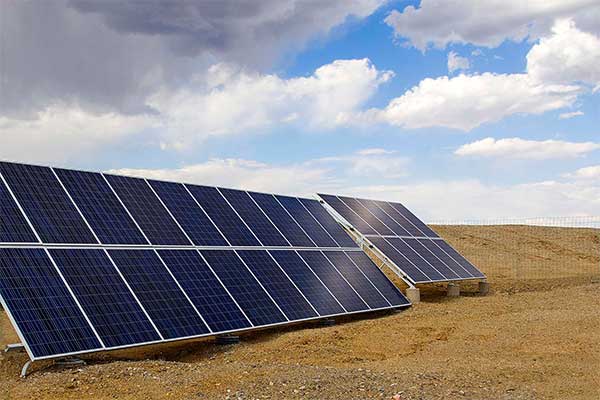
How Solar Panels Generate Electricity
Here’s a step-by-step breakdown of how solar panels generate electricity:
- Absorption of Sunlight: Solar panels are installed in a location where they receive direct sunlight. When sunlight strikes the solar cells, they absorb photons (particles of light) and release electrons from their atoms, creating an electric current.
- Electron Movement: The released electrons are drawn towards conductive metal plates within the solar cells. This movement of electrons creates a flow of electricity.
- Current Collection: The electrical current is collected by metal conductors in the solar panel, and these conductors transport the electricity to the inverter.
- Inversion to AC: The inverter then converts the DC electricity into AC electricity, which is suitable for use in homes, businesses, and the grid.
- Usage and Export: The generated electricity can be used to power electrical appliances or be sent back to the grid for future use, depending on the system setup and local regulations.
Factors Affecting Solar Panel Efficiency
Several factors can impact the efficiency of solar panels:
- Sunlight Intensity: Solar panels work best when exposed to direct sunlight. Cloudy days and shading from trees or buildings can reduce their efficiency.
- Panel Orientation: The angle and direction of the solar panels affect their efficiency. Panels should be oriented to capture the maximum amount of sunlight throughout the day.
- Temperature: Solar panels operate more efficiently at cooler temperatures. High heat can reduce their performance.
- Dirt and Dust: Accumulated dirt and dust on the solar panel’s surface can block sunlight, decreasing their efficiency. Regular cleaning is essential.
Conclusion
Solar panels are a remarkable technology that converts sunlight into electricity, providing a clean and sustainable energy source. As technology continues to advance, solar panels are likely to become an even more integral part of our energy landscape.
The post How Do Solar Panels Work: A Comprehensive Guide appeared first on Blazer.
]]>